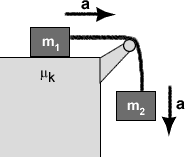
Part I. Do all 8 questions. 5 pts each
1.) The basic units of kinetic energy are:
2.) The tension in the (ideal) string joining m1 and 2 is:

3.) What is the acceleration of the (m1 + m2) system?

4.) In question 3.) what is the force that m2 exerts on m1?
5.) A paper coffee filter of mass 0.001 kg falls in air with a constant downward speed of 0.02 m/s. The force the air exerts on the filter is:
6.) A mass m =1 kg on an ideal string of length r =4m moves in a horizontal circle. The tension of the string is:
 v = 2 m/s
v = 2 m/s
7.) A fan cart of mass 2 kg accelerates from 1 m/s to 3 m/s over a distance of 4 m in exactly 2.0s. Neglect friction. The average power generated by the fan engine is:
8.) If it takes 2 Nm of work to compress an ideal spring 3.0 m, how much work is required to compress it 6.0 m?
1.) Starting with Newton's laws, in terms of m1, m2, g and mk carefully derive an algebraic expression for: (Simplify your final expressions.)

2.) A 1000 kg rocket accelerates from vI = 10 m/s to vf = 30 m/s over a horizontal distance of d = 50 m in a straight line. The rocket mass is approximately constant.
Calculate:
